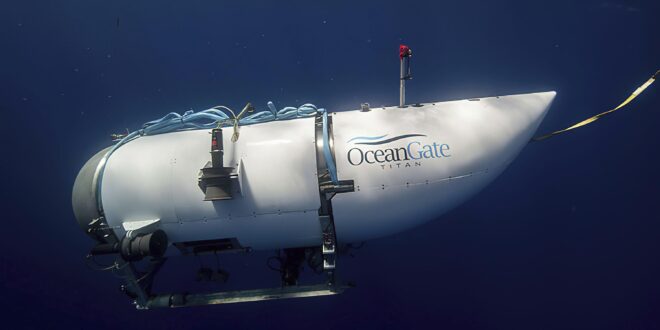Title: Investigation Begins After Implosion of Titan Submersible Raises Questions of Responsibility
Following the implosion of the Titan submersible, officials have commenced the search for evidence on the ocean floor and are grappling with the daunting task of determining who should be responsible for investigating the international disaster. Despite the lack of a formal inquiry, maritime agencies are currently occupied with searching the area where the vessel was destroyed, as stated by the U.S. Coast Guard on Friday. Debris from the submersible was found approximately 12,500 feet underwater near the Titanic wreckage it was en route to explore. The initial search and rescue mission was led by the U.S. Coast Guard.
On Thursday, Rear Adm. John Mauger of the First Coast Guard District acknowledged the numerous questions surrounding the incident and expressed the intent to gather as much information as possible. However, it remains unclear who possesses the authority to lead the complex investigation, which involves multiple countries. While the OceanGate Expeditions, the company that owned and operated the Titan, is based in the U.S., the submersible was registered in the Bahamas. OceanGate, headquartered in Everett, Washington, has temporarily closed its operations since the Titan’s discovery. The Polar Prince, the Titan’s mother ship, is from Canada, and the individuals aboard the submersible hail from England, Pakistan, France, and the U.S.
The National Transportation Safety Board (NTSB) has indicated that the U.S. Coast Guard will spearhead the investigation, classifying the loss of the Titan as a “major marine casualty.” However, the Coast Guard has not yet confirmed its role in leading the investigation. The NTSB, upon receiving information from Coast Guard officials, joined the investigation. Coast Guard headquarters stated that future operations and plans will be discussed by the Coast Guard First District in Boston, without specifying the date. The First District has not responded to requests for comments.
In the meantime, the Transportation Safety Board of Canada has launched an investigation into the Polar Prince, the Titan’s mother ship and support vessel. During the Titan’s journey, the Polar Prince accommodated seventeen crew members and twenty-four others.
The complexity of the overall investigation is compounded by the fact that the world of deep-sea exploration lacks adequate regulation. Such expeditions face less scrutiny compared to companies involved in space launches, according to Salvatore Mercogliano, a maritime history and policy professor at Campbell University in North Carolina. The Titan was not registered as a U.S. vessel or with international safety regulatory agencies. Additionally, it did not possess classification by a maritime industry group that sets standards for hull construction.
In previous instances, OceanGate CEO Stockton Rush criticized regulations for stifling progress, stating that subjecting every innovation to outside scrutiny before real-world testing impedes rapid innovation. The lack of certification by external experts in this particular case has been identified by Bob Ballard, a member of the research team that discovered the Titanic wreck in 1985, as “the smoking gun” behind the implosion. Ballard emphasized that the submersible was the first of its kind to lack classification.
The likely timing of the implosion appears to have been resolved. After the Titan was reported missing on Sunday, the Navy analyzed acoustic data and discovered an “anomaly” consistent with implosion or explosion at the location where communication was lost, as confirmed by a senior U.S. Navy official. Although the Navy shared this information with the Coast Guard, further search efforts continued as the data was not conclusive.
Condolences and tributes to the victims have poured in from around the world. The individuals who perished in the implosion include Rush, two members of a prominent Pakistani family – Shahzada Dawood and his son Suleman Dawood – British adventurer Hamish Harding, and Titanic expert Paul-Henri Nargeolet.
On Sunday, the Titan embarked on its journey and was reported overdue that same afternoon about 435 miles south of St. John’s, Newfoundland. In response, rescue teams swiftly dispatched ships, planes, and other equipment to the area. Any remaining hope of finding the crew alive was shattered on Thursday when the submersible’s 96-hour air supply was expected to run out. Simultaneously, the Coast Guard confirmed the discovery of debris approximately 1,600 feet from the Titanic.
An onslaught of lawsuits is anticipated, though their success may be uncertain due to the complexities involved in establishing jurisdiction, both for the investigation and the legal claims. Steve Flynn, a retired Coast Guard officer and the director of Northeastern University’s Global Resilience Institute, explained that the implosion occurred in a regulatory gray area and consequently lacked oversight. The absence of a clarified jurisdiction allowed certain entities to evade supervision.
Renowned filmmaker James Cameron, famous for directing the blockbuster movie “Titanic” and having made numerous dives to the iconic ship’s wreckage, quickly realized the severity of the situation when he learned that the submersible had lost navigation and communication simultaneously. Cameron expressed certainty that an “extreme catastrophic event” had taken place, negating the need for search efforts. Once an ROV capable of reaching the required depth was deployed, it located the wreckage within hours, possibly minutes.
Norman Polmar, a naval historian, analyst, and author based in Virginia, stressed the unparalleled nature of this ocean search, particularly given the involvement of multiple countries and commercial enterprises.
As the investigation proceeds, the costs incurred are likely to reach millions of dollars for the U.S. Coast Guard alone. The Canadian coast guard, U.S. Navy, and other agencies and private entities have also provided resources and expertise. Despite the potential for reimbursement claims, the U.S. Coast Guard is generally prohibited by federal law from collecting reimbursements related to search and rescue services. Maritime law specialist Stephen Koerting, a U.S. attorney in Maine, highlighted this limitation.
Letters filed by OceanGate with a U.S. District Court in Norfolk, Virginia, responsible for matters involving the Titanic shipwreck site, revealed that at least 46 individuals successfully traveled on the company’s submersible to the Titanic in 2021 and 2022. However, safety concerns have been raised by both a former employee and some former passengers.
Associated Press writers Lolita C. Baldor, Ben Finley, Holly Ramer, David Sharp, and Gene Johnson contributed to this report.
 Mind Uncharted Explore. Discover. Learn.
Mind Uncharted Explore. Discover. Learn.




